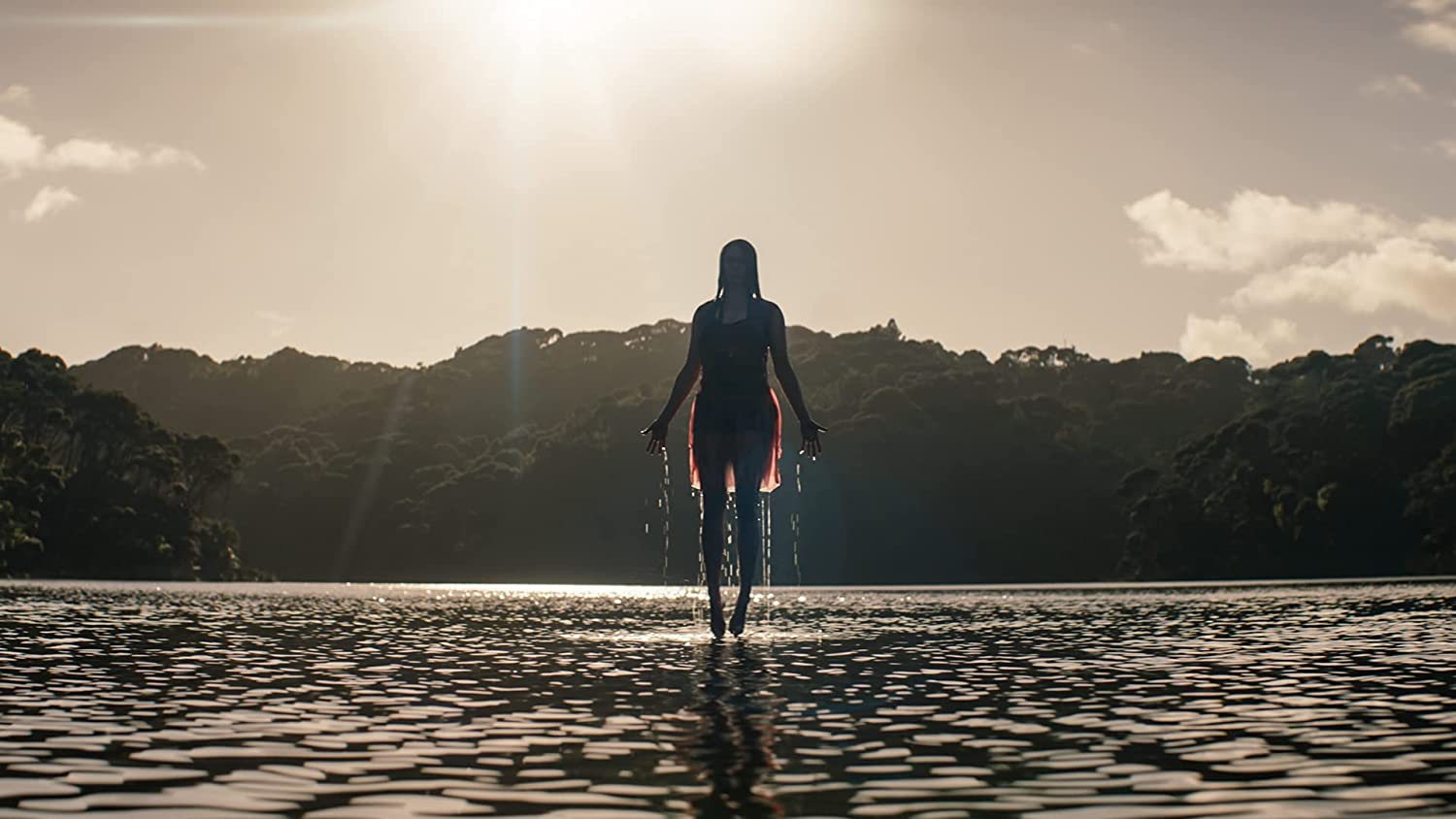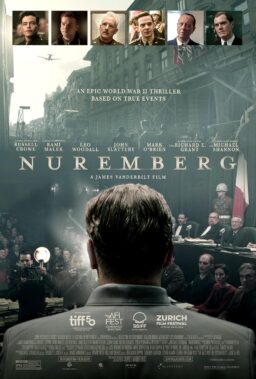Cheese graters, tattoo needles, kitchen scissors—it would be harder to name a household object that isn’t put to exorbitantly gory good use in Lee Cronin’s “Evil Dead Rise,” a gratifyingly lean and impressively mean new installment in the long-running horror franchise.
Kick-started by Sam Raimi’s classic 1981 cabin-in-the-woods cheapie, still an exemplar of independent splatstick ingenuity, the “Evil Dead” series has since comprised two comedic sequels, “Evil Dead 2” and the Hollywood budget-sized “Army of Darkness,” which sent chainsaw-wielding hero Ash Williams (Bruce Campbell) back to medieval times, plus Fede Alvarez’s more brutally intense and dread-steeped 2013 reboot.
“Evil Dead Rise,” which hit theaters earlier this year is now available to rent and own on 4K Ultra HD, is at once a change of pace for the franchise, switching up its stock-in-trade cabin fever to unleash hell on the residents of a run-down city high-rise, and a tongue-in-cheek recapitulation of the hyper-kinetic visual style and vomit-soaked, maggot-infested iconography for which the series is most beloved.
Set in a condemned Los Angeles apartment complex, the film follows two estranged sisters, Beth (Lily Sullivan) and Ellie (Alyssa Sutherland), who fight to survive after Ellie’s children uncover phonograph records and a strange book—one of three volumes of the Naturom Demonto, also known as the Necronomicon—that inadvertently summon demonic entities known as Deadites. Once Ellie is attacked and possessed, her family must confront a mother-monster who intends, with ample ferocity and demented delight, to prey upon their souls.
While his film is just as bloodthirsty as its predecessors, Cronin seasons all the sadism with a gleefully unhinged, ghouls-gone-wild exuberance that invites audiences to embrace every kill as a morbid, rictus-grinning punchline. Simultaneously, the Irish filmmaker—whose creepy 2019 debut, “The Hole in the Ground,” similarly exploited primal fears of motherhood, possession, and unsettlingly dark chasms—infuses “Evil Dead Rise” with an anguished humanity and tragic dimension, courtesy of committed performances by his two lead actresses.
Cronin spoke to RogerEbert.com via Zoom ahead of the film’s home media release about writing dialogue for Deadites, drenching his actors in buckets of blood, and taking the already-iconic cheese grater sequence literally to his grave.
The following interview has been edited and condensed.

“Evil Dead Rise” takes place on the upper floor of a Los Angeles high-rise, in a space your characters are intimately familiar with, which builds a dread distinct from the cabin-in-the-woods setting this franchise is more associated with. Was that setting part of your initial pitch?
It was there from the get-go. I knew I wanted to move as far away from the cabin as I could. It’s not that I had any problem with the cabin; my love for that setting meant I still put a cabin in the movie, in the opening sequence. I love its lore and atmosphere. But it just felt like, for the type of filmmaker I am and the types of stories I want to tell, I needed to separate [this film] and put it into a new context.
Ultimately, what it came down to was that, typically, in the “Evil Dead” movies, people go to a strange place and discover something. In this movie, the evil actually comes in your door, to your place where you’re already comfortable. The characters are surrounded by the trappings of their life, of their existence. They’re not surrounded by odd objects they don’t recognize. The only odd objects in the movie are the Book of the Dead and the vinyl. It’s not like someone picks up a cheese grater in the Airbnb that they’re staying in. It’s the cheese grater they’ve probably used for the last five years, that’s already in their home. That’s why it hits different. That’s what makes the familial aspect work and the characters shine.
“Evil Dead Rise” plays with the series’ mythology while offering variations on its classic themes. We see a copy of Wuthering Heights, as opposed to A Farewell to Arms. Ellie is ensnared by elevator cables rather than tree branches. What was the process of finding those variations?
The balance came from uncovering the characters, the story, and the metaphor first. First of all, I met with Sam Raimi. Obviously, he expressed interest in me, and I expressed interest in “Evil Dead.” The next time I got in a room was with him and Rob Tapert, and I never really talked about which scares would happen or when somebody would get stabbed. I talked about building the characters and the world, what it means and where their headspaces are at, as the fabric of the story.
Once I had that figured out and had their support, I was able to set about creating the horror. It was twofold. I followed my instincts in terms of what I wanted to do. I’d hit upon certain ideas and realize there was an interesting way of making them work in an “Evil Dead” context. As one simple example, there’s a Henrietta’s Pizzeria pizza box, which is directly connected to “Evil Dead 2.” They were always going to eat pizza. I hadn’t come up with that to put a Henrietta’s pizza box in the film. A lot of times, it worked the other way around.
On occasion, when I was writing, I did think about how I just adore the ejection of an eyeball in “Evil Dead 2” and how I wanted to do my own version of that, my own way. I set out my stall early, [with a whooshing tracking shot, achieved using a drone,] that put the audience straight into that iconic forced point-of-view then immediately subverted what it was. I’m saying, “This is familiar, but it’s going to do some different things.” In striking that balance, an early draft of the script might have had another 20 percent of those moments. When it felt like a bit too much, I started to peel some of that back. It’s better to have more than to be searching for enough. If you’re trying to write 10 funny jokes, you go write 50 and then use the best 10. I wish I could remember some things I pulled out from it, but others stuck and became part of the rhythm, the fabric, and the story of this movie in their own right.

That first elevator sequence, which hits 20 minutes in, feels like a gear-shift moment in terms of its brutality and violence. The power fails, the demons attack, and Alyssa Sutherland makes you feel the horror and confusion of Ellie’s predicament, as all these rusty elevator cables snake out to bind her arms and legs. Tell me about that day on set.
That was a great and challenging day. I feel like that was the first day that I had Alyssa on her own, probably the first day on set I had any actor on their own. Up to that point, we’d had the ensemble, the family, so there was always someone else involved. It’s very different when you’re on set and just have to communicate with one person. Shooting in a box is quite difficult, so we had access points, areas we could lift up to get cameras inside. We had to work with stunts a lot. There was a lot of technical work to do, with her hanging.
From memory, I feel like we shot all of that in one day, which is quite a lot. We did it all. We then went back and did inserts, some close-ups of cables binding. There were aspects of it where we experimented, as well, that didn’t make the final cut. I remember experimenting with the idea of her being momentarily possessed in the middle of it and laughing maniacally, as if she’s enjoying the experience. We played around. Still, with one actor in a box, there are not many places you can go with what you can do. It had highly technical moments but also moments of experimentation. I’m very specific with where I put the camera, what the A-to-B movement in a shot is, and what it’s supposed to do. But there were times in that scene where we were more free-form, where we could run the spectrum of the performance, with this sound around her that’s trying to get inside her brain and drive her crazy.
We started shooting from different angles to see what we could find. There weren’t a lot of times in this movie, where there were those discoveries. I’m very specific and scientific in how I work. There’s a bit where Alyssa drops on the floor, and she screams, “Shut the f**k up.” She puts her hands over her ears. We’re not timing the lighting to what she’s doing, but the lighting is going crazy, and there was this perfect moment, a cut to black, that we found. Even though there was a looseness to what we were doing, I immediately played that moment back and recorded it on my phone, said “That’s going in the cut,” and sent it to my editor. It felt like we planned it perfectly. That was a different type of day, and quite an impactful sequence as well, I hope.
The peephole’s fisheye lens gives the audience an uncannily warped, panoramic perspective on Deadite Ellie unleashing carnage up and down the hallways. Was that sequence all done practically and in one take?
The scene through the peephole, where the neighbors are killed, was one very specific piece of ballet, almost done as if it was one shot, because the camera never moved. I envisaged it initially as a single take and then, rhythmically, in the edit, realized I needed to cut back to Beth a few times, so I broke it up. Originally, you look through the peephole, and everything happens, but it needed a rhythm break to create some highs and lows within it. But we rehearsed the entirety of that sequence off-set and with the stunt team, performing it as one shot that includes multiple characters and different things happening. We could digitally clean up wires that were in the way later.
I’ve got a bit of footage somewhere, where Ellie comes around, cleans out Gabriel, he drops out of shot, she turns, Mr. Fonda shoots, there’s a mattress there for her to land on, and she’s blown away as a light comes on. It’s this technical ballet that we have to perform. It was a day we’d rehearsed and were technically rehearsing more and more. I only needed one shot that day, which was 90 seconds. An hour after lunch, we were like, “Should we try one and see how it goes?” We shot it five times, for the rest of the day. I was looking for one perfect take I would play in the movie. In the end, we ended up choosing different bits, once I started to break it up with cuts back to Beth.
You drench your actors in blood throughout “Evil Dead Rise,” to striking effect, and I’m sure it couldn’t have been easy to maintain that fresh, gory look. What was involved in achieving that consistency and wetness, particularly given the need to continually reset while setting up additional camera angles?
That was almost a machine that I wasn’t able to control. Thankfully, I had a brilliant team of people involved, because it goes from costume all the way through to the practical effects people on set, and everything in between in terms of makeup. There were layers you’d build that would become a preset look that would never change, and then it was about those additions. At times, you’re under pressure and know you have to get this shot in one go, because the reset time means you’re going to have to send that person away for 40 minutes and get something else while you do that reset. It was important that the blood was a character in the movie for me: that it felt very vital, that it was all real and sticky, that the actors had to suffer.
I’m always sorry for that, because they didn’t love it. Getting flooded with that blood is not fun. I always think of Lily coming on set and standing with her arms away from her body, with her legs in a stance, so none of her skin was touching off itself, because it would stick immediately. On set, we would say in the schedule that we needed her at 2:30, and she would arrive at 2:30 ready to go, but we’d be 45 minutes behind, so she’s just left in this blood, getting sprayed with water to try to help the stickiness not just fuse and become rock-hard. She’s put some videos online of peeling skin off towels. The good thing, from an actor’s point of view, is that they felt the discomfort, which they were able to then feed into their performances.

One of the most iconic line deliveries that Alyssa Sutherland gets in “Evil Dead Rise” is when she’s possessed and says, “Mommy’s with the maggots now” in the most sickly-sweet, perfectly taunting tone of voice. I’m curious about the process of writing dialogue for Deadites, who torture their victims both physically and psychologically with this diabolical sense of humor.
I can’t actually remember whether I wrote that line the first time I wrote that moment. Initially, she might have said something different. When I get off this call, I’m actually going to look and see whether it was in the first draft. I knew I wanted there to be levity in the movie through the humanity of these characters trying to survive, and that there had to be devastating dark humor as well from what Deadite Ellie says, because she’s a psychopath who’s actually having fun toying with this family. It’s like, “What’s the most sinister thing this mom could say?”
When her child—in this case, Danny—is speaking to her in disbelief but also hopes that she’s still alive, there’s a confusion there, and she sticks the psychological knife right in him. I love that line. I remember, with “Mommy’s with the maggots now,” I really hoped it would end up on a T-shirt someday, and lo and behold it’s now on a T-shirt, so it definitely landed.
The line where she calls her children “titty-sucking parasites” is my favorite, because it’s so icky, and it cuts so close to the bone. The way I thought about at least the process of approaching those types of lines is that it’s saying the things a frustrated mother wants to say but never, ever would, because she loves her children. But now that she is possessed, subverted, and corrupted, she gets to say the darkest version of the challenging thoughts that might go on inside her head.
You mentioned the cheese grater earlier, one of several household objects weaponized in “Evil Dead Rise.” The fight sequence in the kitchen goes to gnarly places, with Gabrielle Nichols’ demonically possessed teenager Bridget at one point scraping said cheese grater along the back of Beth’s calf. It’s one of the grisliest effects in this very grisly film, so I’m curious what went into filming it.
That was a challenging scene. They were all challenging, but we were able to do the majority of that one practically. As a filmmaker, I use CGI to enhance rather than define a moment. There aren’t many CG shots in the film. We were able to pre-set wounds and have things that would move, and we would always have references so we knew what we were getting, for the digital artists that would then work. But there were a lot of phases and stages to that sequence beyond even that part. With catching the cheese grater in mid-air, that catch was done practically, and it was about getting the timing of that right. That was one of my favorite sequences to shoot.
Even with all the support in the world—and I was offered a lot—you don’t always have the time you wish you had. It’s the nature of filmmaking. But for that scene, we were actually in the kitchen for three days. It was so intricate, within this small space that’s about as big as it feels; it’s not enormous to put such a detailed little sequence in. The kitchen is the heart of the home, where devastating things happen, so the cheese grater sequence was challenging from many points of view, but we got enough of it right on set that it was never about, “How is this going to look when we actually finish it?” We just added a few flourishes, a few more strings of “leguini” along the way.
I understand you got a cheese grater tattooed on your arm around the film’s world premiere at South by Southwest this year.
That’s true. It’s my little marker. I decided to embrace it rather than to run away from it. The cheese grater is one I will take to my grave.
“Evil Dead Rise” is now available on Blu-ray, DVD, and 4K Ultra HD.












